The power is out – what do you do to keep food safe? What do you need to discard and what can you refreeze when the power is up again? Download our PDF with food safety tips.
Food Safety Tips in Event of a Power Outage
October 29, 2019
October 29, 2019
The power is out – what do you do to keep food safe? What do you need to discard and what can you refreeze when the power is up again? Download our PDF with food safety tips.
July 1, 2019
The weather is heating up and chances are folks are planning a few summer barbecues. With that in mind, we asked our Nutrition Education team to provide a few helpful tips and here is what the came up with. Enjoy!

June 13, 2019
Do you know how to cook maitake mushrooms? Or how to prepare bok choy? And what’s the difference between acorn squash and spaghetti squash? Our Nutrition Education team answers questions like these at nearly every event they attend. The idea is to set people up for success through thoughtfully prepared menus.
People like Kamurrah, a retired seamstress and artist living on a fixed income in San Francisco. She relies on our food pantry at Bayanihan House for much of her weekly groceries. She recently attended a Nutrition Education class at the pantry to learn how to cook some of the food she received recently. “I love the Food Bank,” Kamurrah says, “I have never eaten so well in my life. With the pantry, I try all kinds of fruits and veggies that I’ve never seen before. But I try it, and I’m always getting new foods that I like. There are vegetables that I didn’t even know how to eat, but I learned how because of the Food Bank.” The classes have expanded her horizons and have empowered her with the skills needed to cook and eat fresh foods she would not have known about or chosen otherwise.
The Food Bank’s food sourcing policy is grounded in the USDA’s Dietary Guidelines for Americans: We always include fresh produce, healthy grains, and proteins in every bag or box of food we send into the community. In fact, 60% of the food we distribute is fresh produce. So, it’s essential that we also empower the people we serve by providing information and education to support healthy eating. Our Nutrition Education program does this every day by providing community members with nutrition classes (just like the one at Bayanihan House), recipes, and cooking demonstrations. We also offer training programs to staff at our nonprofit partners, so they can spread the word about healthy eating and share nutritious recipes for the foods we provide.
Your support today can help feed and empower neighbors in need. Together, we are making sure people have the food…
Please visit our Monthly Giving page today.June 10, 2019
For young people, college can be a stressful whirlwind of unknowns: wondering which classes to take and activities to join, or how to balance earning a little money while making enough time to study. How to afford your next meal shouldn’t be an unanswered question.
But for thousands of students right here in San Francisco and Marin, food insecurity is a daily challenge.
The Food Bank first connected with advocates at San Francisco State University in 2016, when professors and campus health services began seeing more students suffering from lightheadedness, headaches, and weakness from not having enough food. Soon after, our first college pantries launched to ensure that students always have enough food to stay healthy and focus on learning. After all, it’s nearly impossible to take on life’s challenges with an empty stomach.
Elina, a political science major at Dominican University in San Rafael, commutes 40 miles to campus every day from her home in Santa Rosa — a drive that can take two hours each way. She started coming to the pantry in the fall of 2018. “A lot of my downtime isn’t actually downtime — it’s driving time between school and home, so that doesn’t leave a lot of extra time to find food,” Elina says. “I have a friend here who had to live in her car because she couldn’t afford housing. The pantry has been a big deal to students like me.”
Many students like Elina either don’t have time to cook or don’t have access to full kitchens. That’s why our college pantry menu is designed for students on the go: fresh produce, canned protein, granola bars, bread for sandwiches, and bottled juice or sparkling water. It’s been a huge hit. “Sometimes I pick up really great veggies – like carrots – which allows me to skip that trip to the grocery store, which saves me time and money. But today I totally forgot to pack a lunch, so I came by and was able to pick up some healthy protein bars that will last me a week!”
We now serve nearly 1,000 hungry students every week at five college pantries through partnerships with student organizations at San Francisco State University, College of Marin, UCSF Parnassus, Dominican University, and City College of San Francisco. Coming soon we will be establishing pantries at University of San Francisco and the San Francisco Art Institute. And it’s not just healthy food that we deliver ever week. Students get tips and recipes for preparing healthy meals, and also have access to CalFresh (food stamps) enrollment assistance at these institutions
Despite the success of this program, many of our college pantries have extensive wait lists. Your support could help even…
If you’re able, please consider a gift today.June 6, 2019
Monday mornings have a reputation for being kind of a drag. Many of us rush around in an effort to get the work week – or school week – off to a good start, and things can sometimes get hectic.
Food Bank participant Blanca certainly does her fair share of rushing around, getting her kids off to three different schools in San Francisco’s Glen Park neighborhood. But Monday has become a day she enjoys because after dropping off her daughter at Dolores Huerta Elementary School, Blanca heads straight for our weekly food pantry, located right on campus near the school’s playground.
“My oldest eats a lot – he’s 6 feet tall – so it’s hard to keep him happy and full,” Blanca says. “The other kids are big eaters too. But we manage, partly because of the groceries we get here every week.”
Blanca is a stay-at-home mom for now. Her husband is a painter and makes what she describes as a decent wage – but not necessarily enough to get by in San Francisco. Some months are harder than others, but Blanca’s family always seems to get by with a little help from the Food Bank.
“Oh my goodness! It’s not even a joke how hard it is to survive in this city right now,” she exclaims. “There is enough food here every week to provide several days worth of meals, allowing us to save our money to pay for other things that are important, like clothes and medicine.”
As Blanca walks through the pantry, she finds several items that she likes and puts them in her bag. As she holds up a package of fresh asparagus, she explains, “We bake this in the oven so they stay crunchy. We also really like the potatoes; we turn those into baked potatoes and fried potatoes.”
Blanca is certain that her family, and many more in the neighborhood, would suffer greatly if it weren’t for the Monday morning pantry offerings. “Thank you for helping all low-income families in this neighborhood and this city…it really does make a difference.”
May 13, 2019
Pick up a local newspaper, and it’s more likely than not you’ll spot a story about the challenge of homelessness and efforts to tackle it, including recent headlines about plans to build a Navigation Center along San Francisco’s waterfront, and Marc Benioff’s $30-million donation to study homelessness.
Although the Food Bank is not making headlines on this topic, we are diligently working on improving our assistance to *unhoused neighbors every day.
We estimate that a vast majority of the food programs serving unhoused people in San Francisco and Marin today either get fresh groceries for these meals from the Food Bank or partner with us in some way. These include the big congregate meal sites like GLIDE and St. Anthony’s Dining Room in San Francisco and St. Vincent DePaul in Marin. in 2018 at just these three sites, we averaged three deliveries of food each week – totaling 1.4 million pounds of food, equal to about 1.17 million meals.
“Providing our unhoused neighbors with healthy food not only reduces their food insecurity, but in some cases it increases their stability so they can address other life challenges.” says Irene Garcia, Senior Program Coordinator and leader of the Food Bank’s Unhoused Workgroup.
We are building new pantries and partnerships to better serve our region’s unhoused population. That work includes adjusting menus to address limited and even non-cook needs. The goal is to ensure that we are providing products that are appropriate for their cooking and storage facilities.
Read stories about how the Food Bank assists neighbors who are unhoused or formerly homeless:
Health Food for People With No Place To Call Home
The latest 2019 Homeless Counts for San Francisco and Marin are still being tabulated, so the latest data was taken from Point-In-Time surveys conducted in January of 2017.
* The Food Bank has elected to use the term “unhoused” rather than “homeless” when referring to people without a home of their own. We believe the term “homeless” carries with it an implied bias – that because someone does not have a home (s)he is therefore considered “less” important than others. It’s our experience that many people call San Francisco and Marin their home and their community, even though they do not have stable housing at the time. The difference may seem subtle to some but we feel it’s an important distinction.
*Photo by Kevin Butz on Unsplash

strong>WANT TO MAKE A DIFFERENCE? If you would like to make a difference and help feed our unhoused neighbors in…
DONATE TODAYApril 30, 2019
For the first time since 1974, SSI recipients in California are eligible to receive CalFresh benefits. That’s 40,000 people in San Francisco and 3,000 neighbors in Marin – seniors and people with disabilities – who will be newly eligible for food stamp benefits.
With CalFresh benefits for a one-person household averaging $130 a month, this change can make a huge difference for someone in need. And, participating in CalFresh will not reduce SSI benefit amounts in any way.
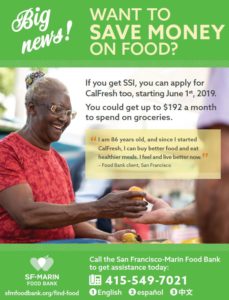
Even conservative estimates suggest that connecting SSI recipients with CalFresh will result in many millions of dollars a year for low-income seniors and people with disabilities to spend on groceries. This won’t just improve the lives of SSI recipients, but the local economy gets a boost too. Every $1 spent in CalFresh benefits generates $1.79 in economic activity!
It took years of dedicated advocacy efforts by our Food Bank and our partners to achieve this historic change, which will improve the lives of some of our most vulnerable neighbors. It wouldn’t have been possible without the generous support of our donors and coalition partners. Thank you!
In the coming weeks and months, the Food Bank’s Policy & Advocacy team and CalFresh Outreach team will work closely with the state, our counties, and other local partners to share this exciting news and assist hundreds of neighbors with CalFresh enrollment.
Are you an SSI recipient interested in applying for CalFresh benefits?
Are you a community-based organization interested in helping your clients enroll?
Want to get engaged with Food Bank’s Advocacy efforts like this?
This historic victory was made possible through the advocacy of the Californians for SSI Coalition (CA4SSI). As a partner and ally in improving the lives of SSI recipients, we want to invite you to join us on one of our CA4SSI membership conference calls every other Tuesday at 11:30am to share updates and discuss strategy. Why stop at CalFresh? Please join us as we advocate to increase the grants to people on SSI!
Check out this video of our listening session with SSI recipients on how hard it is to make ends meet on SSI: www.youtube.com/SSI
Click here to sign up for our eNewsletter and follow us on Twitter @SFMFoodBank
January 25, 2019
It’s a chilly Thursday evening when Samantha and her 7-year-old son, Taye, are climbing the stairs in a multi-story apartment building in San Francisco’s Richmond District. They’re here to deliver a bounty of fresh food to the Pham family – part of the Food Bank’s Home-Delivered Groceries program. And yet, the food is just part of the equation. Their knock on the front door is followed by a warm greeting, smiles, and hugs all around.
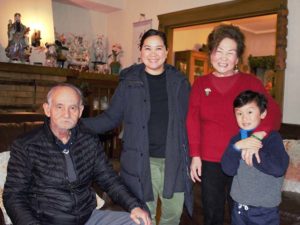 Longtime San Francisco residents, Mr. and Mrs. Pham have come to think of Samantha and Taye like family. The Phams grew up in China and Vietnam and moved to the United States after the Vietnam War. The couple settled in San Francisco, and Mrs. Pham says she has always enjoyed how welcoming and accessible the city has been for them.
Longtime San Francisco residents, Mr. and Mrs. Pham have come to think of Samantha and Taye like family. The Phams grew up in China and Vietnam and moved to the United States after the Vietnam War. The couple settled in San Francisco, and Mrs. Pham says she has always enjoyed how welcoming and accessible the city has been for them.
Long retired, Mr. Pham has limited mobility and rarely leaves their second-floor apartment. Mrs. Pham also has trouble moving around, after suffering a debilitating back injury during the war. Despite these hardships, the Phams stay positive, and appreciate the friendly conversations and nutritious food that Samantha and Taye bring to their doorstep every week.
“For me, it’s very hard to get outside and go to the store, so we are very thankful that this food is brought to us. And, we always look forward to seeing Taye and Samantha every week,” said Mrs. Pham, beaming at Taye, who during this evening’s visit had joined Mr. Pham in his favorite chair.
In December, the Food Bank’s Home-Delivered Groceries Program made its 250,000th delivery. To mark this milestone, San Francisco Supervisor Sandra Fewer joined us and our partners from Richmond Neighborhood Center and Richmond Senior Center to pack groceries for the Pham family and many other HDG recipients.
“Food security is a critical part of what makes and sustains a healthy neighborhood,” says Supervisor Fewer. “This dynamic Home-Delivered Groceries program allows seniors, the fastest growing population in the Richmond District, to age-in-place with community support.”
Founded in 2011, the Home-Delivered Groceries (HDG) Program serves 1,998 homebound seniors and 467 adults with disabilities in San Francisco every week. The program aims to provide nutritious food to vulnerable neighbors, as well as reduce loneliness and foster connections among community members.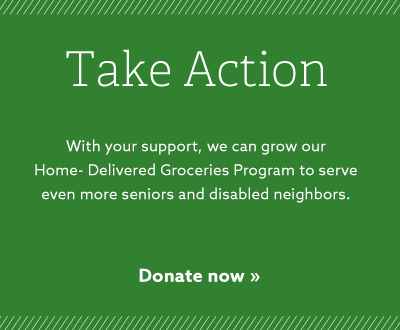
“For thousands of homebound residents in San Francisco, a weekly knock on the door brings not only a delivery of fresh groceries but a friendly visit and some human contact with people who don’t get outdoors very much,” says Jillian Tse, Program Coordinator for the Food Bank.
The HDG program is funded by San Francisco’s Department of Aging and Adult Services (DAAS). Fourteen faith-based and community-based organizations coordinate volunteers and staff to make weekly deliveries. The Food Bank provides nearly 25 pounds of food (on average) for every recipient weekly, including chicken, pasta or rice, and fresh, seasonal produce. The food is tailored to the nutritional needs of seniors and people who are less active because of mobility challenges.
This program is needed now, more than ever, as the population of seniors in San Francisco continues to grow. In 2016, older adults comprised 20% of that population but are projected to rise to 26% by 2030.
January 21, 2019
As the government shutdown continues, the San Francisco-Marin Food Bank is stepping up to assist furloughed workers, including U.S. Coast Guard members and their families who have gone weeks without a paycheck. The Food Bank operated a pop-up pantry on Saturday morning at Hamilton Field in Novato and provided free, fresh groceries to about 150 Coast Guard families.
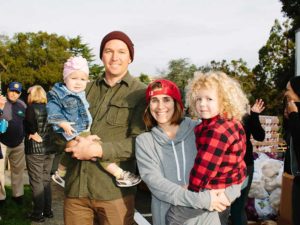
“The food being available here – such great food! – is just amazing. We are overwhelmed with thankfulness,” said Meghan, who came to the pop-up pantry with her husband, who serves in the Coast Guard, and their two young children. “With our kids being so young, I work just a few hours a week, so we rely on my husband’s income to cover most of our bills. Not getting his paycheck last week has already caused us a little bit of hurt. And the prospect of not getting the next paycheck is really scary. Because we’re saving some money on food, we’re able to cover our bills this month. Right now we are just hanging on to every dime, because we’re not sure how long this shutdown is going to last.”
Read thank you letters we received from the U.S. Coast Guard Rear Admiral Peter Gautier and the Coast Guard North Bay Spouses Club.
Click here to view photos from Saturday’s pop-up pantry.
The Food Bank delivered seven pallets of fresh food on Saturday morning- including whole chickens, fruits & veggies, and pasta and sauce – to help the Coast Guard families get through these lean times. In addition, our CalFresh (food stamps) enrollment team was on hand to help eligible families sign up for benefits.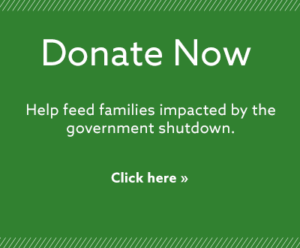 Because they have missed paychecks, many Coast Guard members could now meet income requirements for CalFresh.
Because they have missed paychecks, many Coast Guard members could now meet income requirements for CalFresh.
The Coast Guard families in Novato held their own community food drive last weekend and collected thousands of pounds of nonperishable items, diapers, and cleaning supplies. The fresh groceries from the Food Bank’s pantry supplemented the distribution of these items.
Are you a furloughed government employee who needs food assistance because of the government shutdown? We can help! Call 2-1-1 or visit www.sfmfoodbank.org/find-food to get connected with food assistance in San Francisco and Marin.
With your support, we can continue to help furloughed workers and their families. Make a donation now.
CNN
40k members of the @USCG are now NOT getting paid, marking the first time servicemembers haven’t been paid during a #governmentshutdown. One Coast Guard wife is doing something about it:@SFMFoodBank@MarinHumane pic.twitter.com/1o1IMLtpWl
— Brooke Baldwin (@BrookeBCNN) January 16, 2019
San Jose Mercury News/East Bay Times – Food banks fill in for paychecks as shutdown drags on
Newsweek Magazine – Government Shutdown: Unpaid Federal Workers Are Now Turning to Food Banks To Feed Families
San Francisco Chronicle – Editorial: Crippled Government is the Threat Within
KQED – Bay Area Food Banks prepare to help feed local furloughed federal workers
Marin Independent Journal – Coast Guard Families Tread Water
SF-Eater – Food Bank Hosts Massive Mobile Pantry for Unpaid Coast Guard Workers
December 26, 2018
When the Food Bank truck pulls up to Tomales Elementary School in western Marin County each week, a group of 7th and 8th graders help the principal, Amanda Mattea, distribute food to all the classrooms. It’s part of the Food Bank’s Morning Snack Program which serves nearly 4,700 wholesome snacks to 20 schools throughout San Francisco and Marin each day — foods such as fresh fruit, carrots, and string cheese, giving kids the fuel they need to learn.
Additionally, the Food Bank’s Healthy Children Pantries provide low-income parents with fresh produce, lean proteins, and pantry staples to prepare nutritious meals at home. These pantries are conveniently located in public schools, giving parents easy access to nutritious food as they drop off or pick up their children.
With these two programs, the Food Bank is making a dent in childhood hunger. Hungry children are often tired, have trouble concentrating, and are likely to fall behind in class. They tend to have weaker immune systems, putting them at greater risk of illness. And studies show that kids who grow up hungry or malnourished are not as well prepared for success.
Healthy Snacks Spur Conversations about Healthy Eating
Educators see a big difference when students have enough to eat. “Children’s basic needs must be met before we can even talk about learning,” says Principal Mattea. “Your body needs to be taken care of, and you need nutritious food to eat.”
For the Tomales Elementary children, their bus ride home can take as long as an hour in this rural area of west Marin. So instead of being distributed as a morning snack, Tomales Elementary School distributes snacks from the Food Bank in the afternoon so kids can stay full on their long bus rides home.
Having a filling snack tides them over until dinner so they can do homework and play. “Our kids’ favorite snack is fruit,” says Principal Mattea. “The other day, they were very excited to get oranges, and we talked about all the ways to eat an orange, from orange juice, to fruit salad. It spurred some great conversation about different kinds of snacks and healthy eating.”

Get Food Bank Updates
Privacy & Cookies: This site uses cookies. By continuing to use this website, you agree to their use. To find out more, including how to control cookies, see our Privacy Policy here.

Share